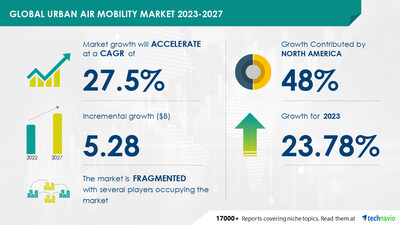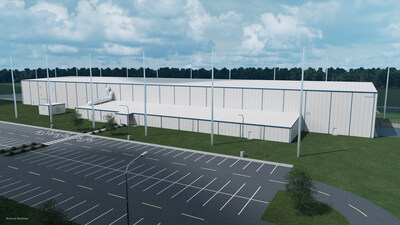Urban Air Mobility Market size is set to grow by USD 5.28 billion from 2023-2027, Increasing use of EVTOL aircraft in military applications to boost the market growth, Technavio
NEW YORK, July 15, 2024 /PRNewswire/ — The global urban air mobility market size is estimated to grow by USD 5.28 billion from 2023-2027, according to Technavio. The market is estimated to grow at a CAGR of 27.5% during the forecast period. Increasing use of EVTOL aircraft in military applications is driving market growth, with a trend towards technological advancements. However, limitations of existing battery technology poses a challenge. Key market players include Airbus SE, Archer Aviation Inc., Bartini Inc., EHang Holdings Ltd., Embraer SA, Geely Auto Group, Honeywell International Inc., Joby Aviation Inc., Kitty Hawk Corp., Lilium GmbH, Lockheed Martin Corp., Moller International, Moog Inc., Raytheon Technologies Corp., The Boeing Co., Volocopter GmbH, Wingcopter GmbH, Wisk Aero LLC, Workhorse Group Inc., and Textron Inc..
Get a detailed analysis on regions, market segments, customer landscape, and companies – Click for the snapshot of this report
Forecast period | 2023-2027 |
Base Year | 2022 |
Historic Data | 2017 – 2021 |
Segment Covered | Type (Autonomous and Piloted), Application (Delivery and Passenger mobility), and Geography (North America, Europe, APAC, Middle East and Africa, and South America) |
Region Covered | North America, Europe, APAC, Middle East and Africa, and South America |
Key companies profiled | Airbus SE, Archer Aviation Inc., Bartini Inc., EHang Holdings Ltd., Embraer SA, Geely Auto Group, Honeywell International Inc., Joby Aviation Inc., Kitty Hawk Corp., Lilium GmbH, Lockheed Martin Corp., Moller International, Moog Inc., Raytheon Technologies Corp., The Boeing Co., Volocopter GmbH, Wingcopter GmbH, Wisk Aero LLC, Workhorse Group Inc., and Textron Inc. |
Key Market Trends Fueling Growth
The urban air mobility market is witnessing significant trends, with the adoption of real-time tracking technology for last-mile delivery management being a major one. This enables consumers to manage and modify package deliveries using online tools, providing greater transparency and control. Large packages require customer pick-up due to their value, posing a challenge for delivery providers. To address this, they offer web and mobile applications for managing delivery schedules of large cargo. Real-time updates on delivery status, traffic, and weather help customers plan accordingly. Big data is also optimizing last-mile delivery, with companies like DHL using it to determine optimum delivery routes. Technologies such as automation, online updates, real-time tracking, and delivery time estimations are already in use. Retailers like Amazon are exploring drone technology, while autonomous ground vehicles (AGVs) and autonomous delivery vehicles (ADVs) are gaining popularity. Regulatory challenges will be addressed in the next decade, driven by automotive manufacturing companies. These technological advances are expected to positively impact the growth of the urban air mobility market.
Urban Air Mobility (UAM) and Advanced Air Mobility (AAM) are revolutionizing transportation in metropolitan areas with flying taxis, cargo air vehicles, and drones. These innovative urban aviation services aim to reduce traffic congestion and improve productivity. Courier services and public transportation are exploring shared automated vehicles and on-demand mobility solutions. Electric power is a key trend, with electric aircraft and drones leading the charge. Volocopter, a leading player, is merging with Uber to expand their platform operations. Range and platform architecture are crucial considerations for air taxis and personal air vehicles. Rotary wings and fixed wings hybrid vehicles cater to intercity and intracity travel. Cargo, emergencies, and people transportation are all part of this growing ecosystem. New technology, collaborations, and intelligent aerial vehicles are shaping the future of transportation businesses. Infrastructures and fuel are essential elements in the development of this sustainable solution for metropolitan economies.
Discover 360° analysis of this market. For complete information, schedule your consultation- Book Here!
Market Challenges
• The urban air mobility market for electric vertical takeoff and landing (eVTOL) aircraft faces significant challenges due to the limitations of current battery technology. Achieving the energy requirements for flight is a major obstacle, as batteries must be lightweight yet deliver a high energy density of at least 500Wh/kg for commercial payload-range aircraft. Most commercial batteries can only provide 30-50% of this, resulting in a maximum range of 200-400 miles. To meet the market’s demands, advancements in battery technology are crucial. These advancements must focus on increasing energy density, improving re-charging speeds, and extending battery lifecycles. Until these advancements are made, the urban air mobility market’s growth will be restricted.
• Urban Air Mobility (UAM) market is experiencing significant growth with new players entering the scene. Challenges include mergers and acquisitions, collaborations, and strategic partnerships between key players like Volocopter, Jaunt Air Mobility, and Microsoft. Electric power is a major focus with the development of intelligent aerial vehicles using rotary wings and fixed wings hybrid technology. Range and platform operations are crucial for air taxis and personal air vehicles, while cargo air vehicles and last-mile delivery vehicles require specific load-carrying capacity. Platform architecture, autonomy level (piloted or autonomous), intercity and intracity applications, and fuel efficiency are essential considerations. Sustainable transportation systems, refurbishing of existing infrastructures, and the use of a cloud-based computing system are smart strategies for transportation businesses adapting to this new technology. The UAM ecosystem includes various players from people movers to cargo and emergency services, requiring diverse solutions for metropolitan areas. Infrastructures, productivity, and passenger experience are key factors in the success of UAM. New technology, such as eVTOL assembly plants and aerial delivery drones, is driving innovation in this sector.
For more insights on driver and challenges – Download a Sample Report
Segment Overview
This urban air mobility market report extensively covers market segmentation by
- Type
- 1.1 Autonomous
- 1.2 Piloted
- Application
- 2.1 Delivery
- 2.2 Passenger mobility
- Geography
- 3.1 North America
- 3.2 Europe
- 3.3 APAC
- 3.4 Middle East and Africa
- 3.5 South America
1.1 Autonomous- Autonomous Urban Air Mobility (UAM) refers to the utilization of unmanned aerial vehicles (UAVs) or drones for transportation in urban areas. This technology intends to offer cities a secure, efficient, and eco-friendly air transportation alternative, minimizing traffic congestion and enhancing mobility. Autonomous UAM vehicles function independently and incorporate advanced technologies like sensors, navigation systems, and artificial intelligence algorithms. Morgan Stanley Research’s equity analysts, in a recent BluePaper, discuss the accelerating investment in autonomous flying aircraft, with implications for passenger travel, military and defense, and freight and package transportation sectors. The report projects a USD1.5 trillion total addressable market for autonomous aircraft by 2040, providing lucrative opportunities for investors and positively impacting various industries, thereby fueling the demand for UAM throughout the forecast period.
For more information on market segmentation with geographical analysis including forecast (2023-2027) and historic data (2017 – 2021) – Download a Sample Report
Learn and explore more about Technavio’s in-depth research reports
The global Aerospace Artificial Intelligence market is rapidly expanding, driven by advancements in machine learning and autonomous systems, enhancing flight safety, efficiency, and predictive maintenance. Major players include Boeing and Airbus.
The global eVTOL Aircraft market is revolutionizing urban mobility with electric vertical takeoff and landing aircraft, promising reduced congestion and lower emissions. Key players are Joby Aviation and Lilium.
The global Air Conditioning market is growing steadily due to rising temperatures and urbanization, with smart, energy-efficient units gaining popularity. Leading companies include Daikin and Carrier.
Research Analysis
The Urban Air Mobility (UAM) market is revolutionizing the transportation industry by offering sustainable solutions for goods delivery services and on-demand mobility in metropolitan areas. Traffic congestion is a major challenge in densely populated cities, and UAM provides an efficient alternative with electric aircraft, flying taxis, and personal air vehicles. The market is witnessing significant mergers & acquisitions and collaborations between key players to strengthen their ecosystems. Platform operations play a crucial role in managing the complexities of UAM, including range, platform architecture, and air traffic control. Cargo air vehicles, drones, and air ambulances are also part of the UAM ecosystem, offering productivity gains for transportation businesses. Last-mile delivery vehicles and fuel efficiency are key considerations for the success of UAM. The future of UAM holds the potential to transform urban transportation and boost the metropolitan economy.
Urban Air Mobility (UAM) and Advanced Air Mobility (AAM) are revolutionizing urban transportation with their innovative solutions. UAM refers to the use of aircraft and other flying vehicles for urban aviation services, including courier services and shared automated vehicles. These technologies aim to reduce traffic congestion in metropolitan areas and boost the metropolitan economy. Sustainable solutions, such as electric aircraft and drones, are at the forefront of this movement. Flying taxi services and personal air vehicles are becoming a reality, with companies developing electric powertrains, rotary wings, and fixed-wing hybrids. The ecosystem includes mergers & acquisitions, collaborations, and the development of platforms and platform operations. The range of these vehicles varies, from intercity to intracity travel, and they can be piloted or autonomous. Cargo air vehicles and last-mile delivery vehicles are also part of this new transportation paradigm. The passenger experience is a key focus, with companies investing in intelligent aerial vehicles, smart strategies, and sustainable transportation systems. Infrastructures, such as refurbished runways, are being developed to support this new mode of transportation. Companies like Microsoft are investing in cloud-based computing systems and partnerships with UAM players like Volocopter, Jaunt Air Mobility, and eVTOL assembly plants to advance the industry. The future of transportation is taking flight.
Table of Contents:
1 Executive Summary
2 Market Landscape
3 Market Sizing
4 Historic Market Size
5 Five Forces Analysis
6 Market Segmentation
- Type
- Autonomous
- Piloted
- Application
- Delivery
- Passenger Mobility
- Geography
- North America
- Europe
- APAC
- Middle East And Africa
- South America
7 Customer Landscape
8 Geographic Landscape
9 Drivers, Challenges, and Trends
10 Company Landscape
11 Company Analysis
12 Appendix
About Technavio
Technavio is a leading global technology research and advisory company. Their research and analysis focuses on emerging market trends and provides actionable insights to help businesses identify market opportunities and develop effective strategies to optimize their market positions.
With over 500 specialized analysts, Technavio’s report library consists of more than 17,000 reports and counting, covering 800 technologies, spanning across 50 countries. Their client base consists of enterprises of all sizes, including more than 100 Fortune 500 companies. This growing client base relies on Technavio’s comprehensive coverage, extensive research, and actionable market insights to identify opportunities in existing and potential markets and assess their competitive positions within changing market scenarios.
Contacts
Technavio Research
Jesse Maida
Media & Marketing Executive
US: +1 844 364 1100
UK: +44 203 893 3200
Email: [email protected]
Website: www.technavio.com/
![]() View original content to download multimedia:https://www.prnewswire.com/news-releases/urban-air-mobility-market-size-is-set-to-grow-by-usd-5-28-billion-from-2023-2027–increasing-use-of-evtol-aircraft-in-military-applications-to-boost-the-market-growth-technavio-302195685.html
View original content to download multimedia:https://www.prnewswire.com/news-releases/urban-air-mobility-market-size-is-set-to-grow-by-usd-5-28-billion-from-2023-2027–increasing-use-of-evtol-aircraft-in-military-applications-to-boost-the-market-growth-technavio-302195685.html
SOURCE Technavio





 Private Internet Access gives you unparalleled access to thousands
of next-gen servers in over 83 countries and each US state. Your
VPN experience will always be fast, smooth, and reliable.
Private Internet Access gives you unparalleled access to thousands
of next-gen servers in over 83 countries and each US state. Your
VPN experience will always be fast, smooth, and reliable.

